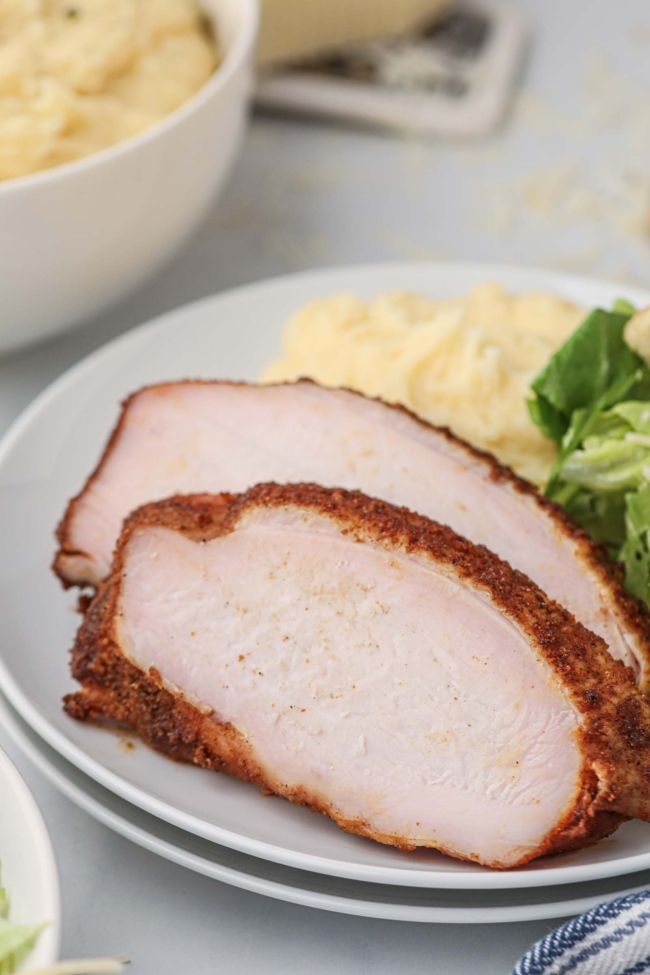This smoked turkey breast recipe is simple, delicious, and perfect for anyone wanting to try smoking a turkey for the first time! It’s packed with flavor and so easy to make.
The brine and slow cooking process keeps the turkey super juicy. You don’t need any special tricks or equipment here. Just follow the steps, and you’ll be carving up a smoky, tender turkey breast with very little effort.
I’ve also provided a suggested timeline to help you determine the best time to start, ensuring the turkey is ready in time for Thanksgiving dinner.
This recipe was made with a 4-pound turkey breast on a Traeger, but any kind of smoker will work. It’s also naturally gluten-free, dairy-free and paleo.
With the holidays around the corner, smoked turkey is a great alternative to roasting. It’s less hands-on, leaving you free to prep sides or spend more time with family. And while this recipe is perfect for Thanksgiving, it’s just as good for weekend dinners or summer cookouts!
There are several ways to cook a turkey breast that make it convenient and easy to get a lean dinner on the table, such as this Air Fryer Turkey Breast or this Instant Pot Turkey Breast.
But once you learn how to smoke a turkey breast, you’ll realize it’s a lot easier than it sounds. And don’t worry – if you’re new to smoking, the recipe is simple and easy to follow.
Smoked turkey breast will always win over any other type of turkey. It’s so much juicier and flavorful!
The photographer said she doesn’t like turkey, and even she ate this turkey breast. She said, “I don’t care for the taste of turkey, and I usually find it to be really dry; this was none of those, and I’ll definitely be making it again.”
I’ve had this and several other smoked turkey recipes ready to share since summer. This month has been awful for me, and I haven’t been up to working. So expect a bunch of recipes coming your way until Thanksgiving!
Ingredients
Here’s what you’ll need.
For the brine
- Water – helps dissolve the salt and sugar, creating a flavor base for the brine.
- Ice water – cools down the brine after the initial heating so you can add the turkey immediately.
- Coarse sea salt – seasons the turkey, locking in moisture for juicy, flavorful meat.
- Brown sugar – adds a hint of sweetness to balance the salt, adds depth to the turkey flavor, and caramelizes the skin, giving it a touch of sweetness and color. Use coconut sugar if you’re paleo. This is also used in the rub.
- Kosher salt – adds flavor and helps form a crust on the turkey.
For the rub
You can customize your rub based on what you like. If you’re not a fan of a particular spice, like cayenne pepper, omit it.
If you’re gluten-free, dairy-free or paleo, just make your store-bought rub is compliant.
- Black pepper – gives a touch of spice and depth to the flavor.
- Sweet paprika – adds color and a mild smoky flavor.
- Garlic powder – infuses the turkey with a rich, savory taste.
- Cayenne pepper – gives a hint of heat. You can adjust based on your spice preference.
- Boneless turkey breast – I talk more about what kind you want below.
- Olive oil – helps the rub stick to the turkey and keeps the skin crispy. Any neutral oil like canola or vegetable oil will work fine. Just keep in mind that olive oil adds a nice flavor that complements the spices in the rub.
Salt conversion
Since salt types vary in texture and density, it’s always best to measure by weight if possible. One thing that drives me crazy about smoked recipes is that they often just say “salt.” There are so many different types of salt!
For the brine, you can use one of these:
- 1/2 cup Morton Coarse Kosher Salt
- 14 tablespoons Diamond Crystal Kosher Salt
- 6 tablespoons table salt
Or just weigh it! You need 125 grams.
For the rub, I just kept it simple and used 2 tablespoons (42 grams) of table salt. But you can use whatever salt you’d like and keep in mind the conversions above. Or again, just weigh out 42 grams of whatever salt you have.
Boneless vs. bone-in turkey breast
Use a fresh, boneless turkey breast (around 4-6 pounds or 1.8-2.7 kg) that hasn’t been pre-seasoned. Thaw it overnight in the fridge if it’s frozen.
If you can only find a bone-in breast, place it bone-side down on the grill.
Cooking times would be different for a bone-in turkey breast than a boneless one.
Bone-in turkey breasts generally take longer to cook because the bone helps retain heat and moisture, slowing the cooking process. This can add about 30-45 minutes to the cooking time compared to a boneless breast of the same weight.
It’s crucial to use a meat thermometer to accurately gauge the internal temperature, regardless of whether you’re using a bone-in or boneless breast.
The safe internal temperature for poultry is 165 °F (74 °C). You’ll take it out of the smoker at 160 °F (71 °C) as it will continue to cook and come to temperature as it rests.
Turkey breast size
Boneless turkey breasts typically range in size from 2 to 8 pounds (907 grams to 3.6 kg), with 3 to 6 pounds (1.4 to 2.7 kg) being the most common.
Smaller boneless turkey breasts (around 2 to 3 pounds) are often ideal for smaller gatherings, while larger ones (5 to 8 pounds) are better suited for feeding a larger group.
How much to buy
When planning to serve smoked turkey breast, a good rule of thumb is to buy about 1/2 to 3/4 pound (226 to 340 grams) of turkey breast per person. This should account for the weight lost during cooking and provide a generous portion for each guest.
Here’s a simple guide:
- For smaller appetites or if you have multiple side dishes, 1/2 pound (226 grams) per person should be sufficient.
- For larger appetites or fewer side dishes, aim for 3/4 pound (340 grams) per person.
For example, if you’re serving 10 people:
- At 1/2 pound per person, you would need 5 pounds (2.3 kg) of turkey breast.
- At 3/4 pound per person, you would need 7.5 pounds (3.4 kg) of turkey breast.
It’s always a good idea to round up a bit to ensure you have enough, and leftovers are great in sandwiches!
Do I have to brine it?
No, but it’s highly recommended. Brining is a great idea for smoked turkey breast because it enhances flavor, improves texture, and helps retain moisture.
Here’s why:
Moisture retention – the salt in the brine helps the turkey absorb and retain water, keeping the meat juicy even after hours of smoking.
Flavor infusion – brining allows flavors from the salt, sugar, herbs, and spices to penetrate deeply into the meat, resulting in a more flavorful turkey breast.
Tender texture – the brining process breaks down proteins in the meat, making the turkey breast more tender.
Smoke enhancement – a well-brined turkey breast often takes on smoke more evenly and develops a beautifully seasoned crust.
Best woods for smoked turkey breast
For today’s recipe, along with this Smoked Spatchcock Chicken, I prefer a touch of sweetness in the smoke using apple, cherry, pecan and maple.
Woods like hickory and mesquite offer a bold, smoky flavor. They’re great for smoking meats, but their intense flavor can overwhelm the turkey.
For comparison, this Smoked Ribeye Recipe is great with classic options like oak, hickory, and mesquite for a bold smoky flavor.
How to smoke turkey breast
Smoking a turkey breast takes a little prep, but it’s worth it, and once it’s ready to smoke, there’s very little else to do except wait.
Here’s an overview of how to smoke a turkey breast. For detailed instructions, scroll to the recipe box at the bottom of the page.
Start by brining the turkey. Brining just means soaking it in salt water with some sugar added. This step keeps the turkey juicy and seasoned all the way through. No more dry turkey!
Next, pat the turkey dry, which helps the rub stick. Dry skin also allows the turkey to develop a crispier texture during smoking. Moisture on the surface can create steam, which prevents the skin from becoming golden and crisp.
Mix up your rub and rub it all over the turkey, and don’t forget to add it between the skin and meat for extra flavor.
Place the turkey skin-side up on the grill, which helps the skin crisp up, and the meat stays juicy because the fat on the skin slowly melts into it.
Smoke it low and slow at 225 °F (107 °C) for about 2.5 to 4.5 hours (it needs about 30-40 minutes per pound) or until the internal temperature reaches 160 °F (71 °C) in the thickest part of the breast (without touching the bone, if applicable).
You’re not going to get the skin crisp by smoking it at a low temp. If you want it a bit crisper, you can do a high-temperature finish.
How to crisp up the skin
First, lightly coat the breast with oil or butter (if you can have dairy) for optimal crisping.
If using a smoker, check that the smoker can handle higher temperatures without creating excess smoke that could overwhelm the flavor. You can also use a grill or oven for this step.
Switch to a higher temperature, 375 °F-400 °F (190 °C-200 °C), when the internal temperature of the turkey breast reaches around 140 °F-150 °F (60 °C-65 °C). This allows the skin to crisp up without overcooking the meat.
Monitor closely during this stage to avoid drying out the turkey. The goal is to reach a final internal temperature of 160 °F (71 °C) in the thickest part of the breast.
Plan for the higher temperature stage to last about 20–30 minutes, depending on your smoker or oven’s efficiency.
But don’t expect miracles. It’s not going to get super crispy like fried chicken skin.
Why no foil pan?
- Better smoke circulation – placing the turkey directly on the grill allows for improved airflow and greater smoke exposure, enhancing the flavor and giving the skin a smoky crust.
- Crispier skin – grilling directly promotes even heat circulation, which helps achieve crispier skin, especially if the temperature is increased toward the end of cooking, as this recipe calls for.
- Even cooking – direct grilling ensures heat is distributed more evenly around the turkey, leading to consistent cooking.
If you use a foil pan:
- The bottom of the turkey will sit in drippings, potentially making the skin soggy and reducing smoke penetration.
- Foil pans are useful for catching drippings for gravy or retaining moisture. For balance, consider placing the turkey on a rack inside the pan to allow some smoke circulation while collecting drippings.
Why don’t you tent it?
Tenting the turkey while resting helps keep it hot but can steam the skin, making it soft. For crisp skin, avoid tenting.
The turkey will stay hot enough without it, and the skin will remain crisp.
Tips
- Use a thermometer – it’s essential for smoked recipes. You can’t go by color or time!
- Baste – if the turkey looks dry, baste the turkey breast every hour with olive oil.
- Let it rest – let the turkey rest for 15-20 minutes. This lets the juices settle, making carving easier and keeping the meat juicy.
Suggested timeline
Smoking a turkey breast typically takes about 30 to 40 minutes per pound at a temperature of around 225 °F (107 °C). However, cooking times can vary based on factors such as the specific smoker you are using, the consistency of the temperature, and the size and shape of the turkey breast.
To have your smoked turkey breast ready to cut for a 12 p.m. Thanksgiving meal, here’s a suggested timeline for a 6-pound turkey breast.
Day before serving:
- Any time between 6 a.m. and 10 p.m. – start brining the turkey breast. If you want to brine for 24 hours, start at 6 a.m. If you want an 8-hour brine, start brining at 10 p.m.
Day of serving:
- 6 to 7 a.m. – remove the turkey from the brine, pat it dry, and let it rest at room temperature for 30 minutes to 1 hour to take off the chill.
- 7 to 7:15 a.m. – prepare the rub and preheat the smoker to 225 °F. Allow it to heat up for about 15 minutes with the lid closed.
- 7:15 to 7:30 a.m. – coat the turkey with olive oil and apply the rub, making sure to coat evenly, including under the skin.
- 7:30 a.m. – place the turkey breast in the smoker, skin side up. Insert the thermometer into the thickest part of the breast.
- 7:30 to 11:00 a.m. – smoke the turkey breast for about 2.5 to 4.5 hours, depending on the size of the breast. You’ll want to aim for the internal temperature to reach 160 °F (71 °C) by 11:00 a.m. If you want to crisp up the skin, then remember to follow the optional step.
- 11:00 a.m. – check the internal temperature. If it’s close to 160 °F (71 °C), you can check it every 15 minutes to avoid overcooking. If it’s not quite there yet, let it smoke a little longer. If it looks dry, baste with olive oil.
- 11:30 to 12:00 p.m. – once the turkey reaches the desired temperature, remove it from the smoker. Let it rest for 15 to 20 minutes.
- 12:00 p.m. – carve and serve the turkey breast.
What to serve with the turkey breast
I have loads of Thanksgiving recipes on my other blog that range from colorful side dishes like these Rainbow Carrots to amazing desserts and drinks.
Any of these would go great with this smoked turkey:
- Dairy-free Cornbread
- Red-skinned Mashed Potatoes
- Whole Wheat Dinner Rolls
- Sweet Potato Goat Cheese Salad
- Sweet Potato Mac and Cheese
- Pear Cider
And maybe this is weird, but I love Buttermilk Biscuits with this smoked turkey! I know they’re more of a breakfast thing, but I love them with dinner, too.
How to make ahead
You can make this smoked turkey breast ahead of time, but I think it’s much better served on the day of the event.
If you need to make it a day or two before, follow the recipe, and after letting it rest, wrap it tightly in foil and store it in the fridge.
When you’re ready to serve, brush the turkey with olive oil to keep it moist and reheat it at 300 °F (150 °C) for about 20-30 minutes. The time might vary depending on the size of the turkey breast.
How to store
To store leftovers, wrap the turkey in plastic or foil, then place it in an airtight container. It’ll keep in the fridge for about 3-4 days.
Smoked turkey is fully cooked during the smoking process, making it safe to eat cold directly from the fridge.
Cold smoked turkey works wonderfully in sandwiches, salads, wraps, or even as a snack with cheese and crackers.
How to freeze
For longer storage, wrap the smoked turkey tightly in plastic wrap, then foil, and place it in a freezer bag to freeze it. It’ll keep for 2-3 months.
To reheat, thaw it overnight in the fridge, then warm at 300 °F (150 °C). To prevent dryness, lightly brush the smoked turkey breast with olive oil before warming.
How long to rest turkey breast before carving?
To ensure a moist turkey, it’s essential to let it rest after cooking. This allows the juices to redistribute throughout the meat, preventing them from running out when carved.
A resting time of 20-30 minutes is generally recommended.
Can you smoke a frozen turkey breast?
Unfortunately, you’ll need to thaw the frozen turkey breast in the refrigerator overnight before smoking. Simply place it on a plate or tray and let it thaw.
Smoking a frozen turkey requires low, slow heat for an extended period, which can result in uneven cooking. If you used a frozen turkey breast, the outer layers would cook while the inner parts remain frozen, posing a food safety risk.
Gluten-free, dairy-free, paleo
This smoked turkey recipe is naturally all those things! Except for paleo, you’ll want to use coconut sugar instead of brown sugar.
Double-check any store-bought rubs to ensure they’re compliant if you’re swapping the homemade spice mix.
Spices are naturally gluten-free and dairy-free. However, certain store-bought spice blends might include gluten/dairy-containing ingredients such as wheat. Cross-contact during processing can also be a concern, even for single spices.
So check the labels and find one labeled as gluten/dairy-free if that’s a concern.
I hope you’ll enjoy this smoked turkey breast! If you try it out, I’d love to hear your thoughts in the comments below. Thanks! 🙂

Smoked Turkey Breast
Ingredients
Brine:
- 2 quarts (1.9 liters) water
- 2 quarts (1.9 liters) ice water combined volume of ice and water should be 2 quarts
- 1/2 cup (125 grams) kosher salt 1/2 cup Morton Coarse Kosher Salt, or 14 tbsp Diamond Crystal Kosher Salt, or 6 tbsp table salt
- 1/4 cup (50 grams) brown sugar or coconut sugar
Rub:
- 2 tablespoons (25 grams) brown sugar or coconut sugar
- 2 tablespoons (42 grams) table salt
- 1/2 tablespoon black pepper
- 1 tablespoon sweet paprika
- 1 tablespoon garlic powder
- 1 teaspoon cayenne pepper
Turkey:
- 1 boneless turkey breast see notes
- 1/4 cup (60 ml) olive oil
Instructions
Brine the night before:
- In a large pot, combine 2 quarts of water, salt, and sugar. Stir over medium heat until the salt and sugar dissolve completely.
- Remove from heat, add the ice water and stir.
- Submerge the turkey breast in the brine, making sure it's fully covered. Use a plate, a stack of plates or another heavy object to weigh it down if necessary.
- Refrigerate for 8 to 24 hours.
30-60 minutes before smoking:
- Remove the turkey breast from the brine, and pat dry. Transfer the turkey to a large plate (or whatever you want) and let sit for 30 minutes to 1 hour.
- In a small bowl, mix together all rub ingredients.
Smoke:
- Preheat your smoker to 225 °F (107 °C) with the lid closed for about 15 minutes. Apple, cherry, pecan and maple are good wood choices.
- Coat the turkey breast lightly with olive oil to help the rub stick, including between the skin and the meat. Generously apply the rub to the entire turkey breast, making sure to coat it evenly and get the area between the skin and meat.
- Place the turkey breast on the smoker, skin side up, directly on the grill grates. Place the probe/themometer into the thickest part of the breast.
- Smoke at 225 °F (107 °C) for about 2.5 to 4.5 hours (it needs about 35-45 minutes per pound), or until the internal temperature reaches 160 °F (71 °C) in the thickest part of the breast. If it’s starting to look dry, you can baste the turkey breast every hour with olive oil. If you want to crisp up the skin,
- Once the turkey reaches the desired temperature, remove it from the smoker and let it rest for 15 to 20 minutes. During resting, the internal temperature should rise to 165 °F (74 °C). After the resting period, carve the turkey breast and serve.
- To store leftovers, wrap the turkey in plastic or foil, then place it in an airtight container. It’ll keep in the fridge for about 3-4 days.
Notes
- The turkey breast in the photo was 4 pounds (1.8 kg), but this recipe and the estimated times given are good for up to a turkey breast of about 6 pounds (2.7 kg). If yours is larger or smaller, just keep in mind you’ll need more or less time than the approximate times given.
- Do NOT use a turkey breast that's already been salted/brined/injected/basted/enhanced. If that's all you can find, then skip the brine in this recipe.
- It should be thawed if frozen.
- If you can only get a bone-in turkey breast, then place it bone-side down on the grill with the breast facing up.

















Leave A Reply!